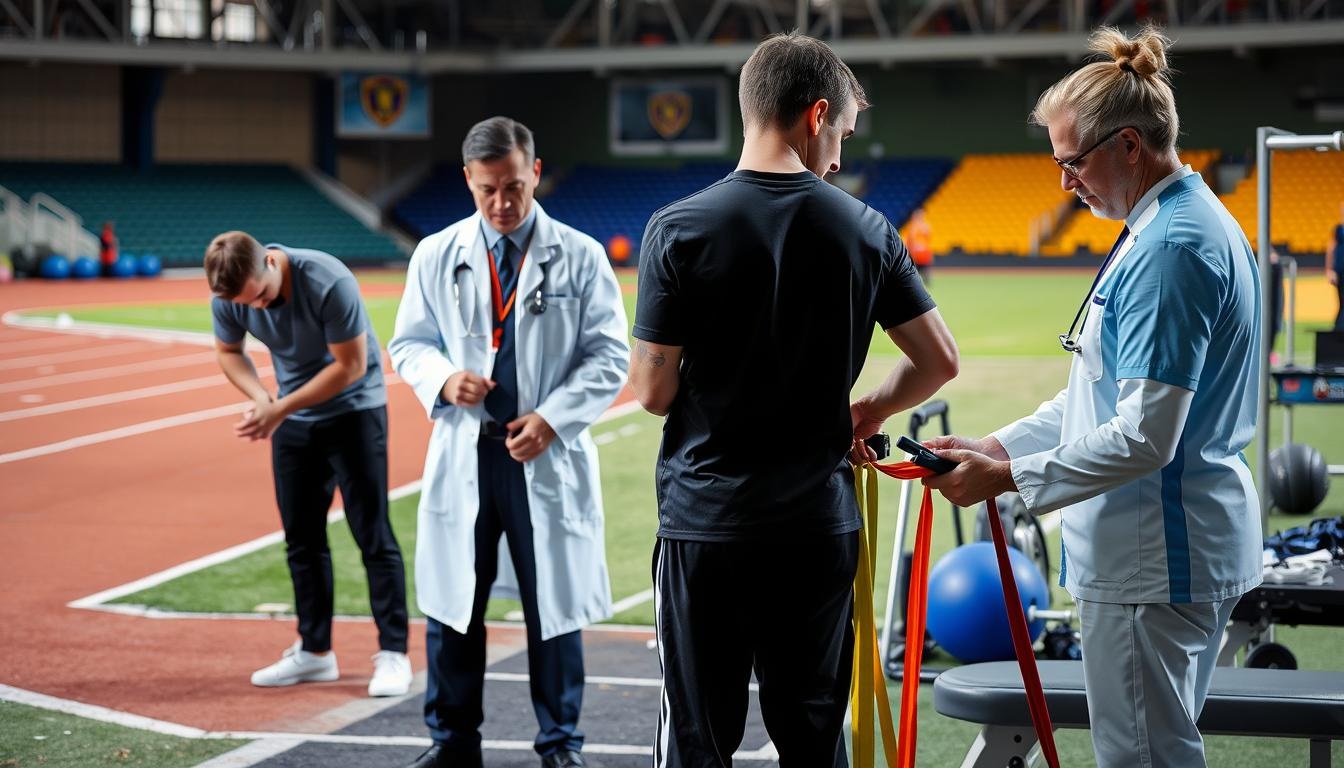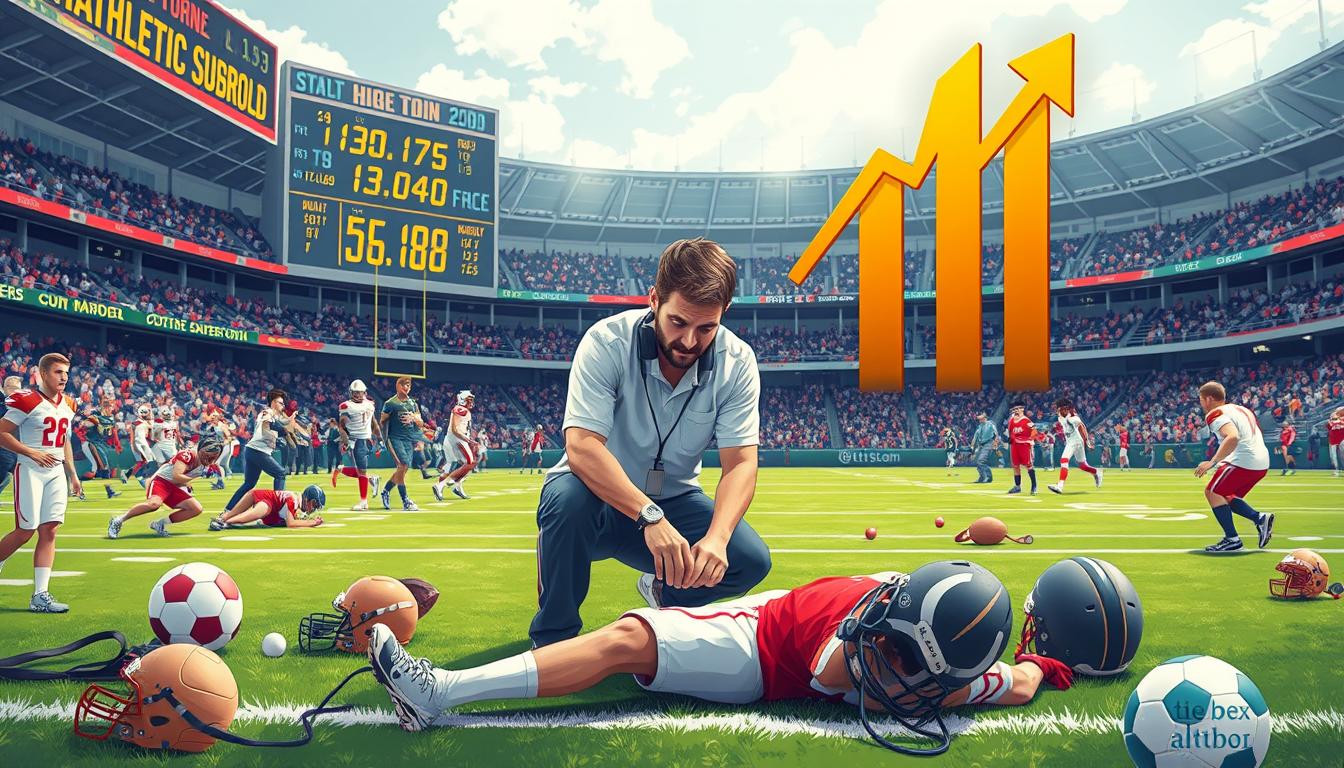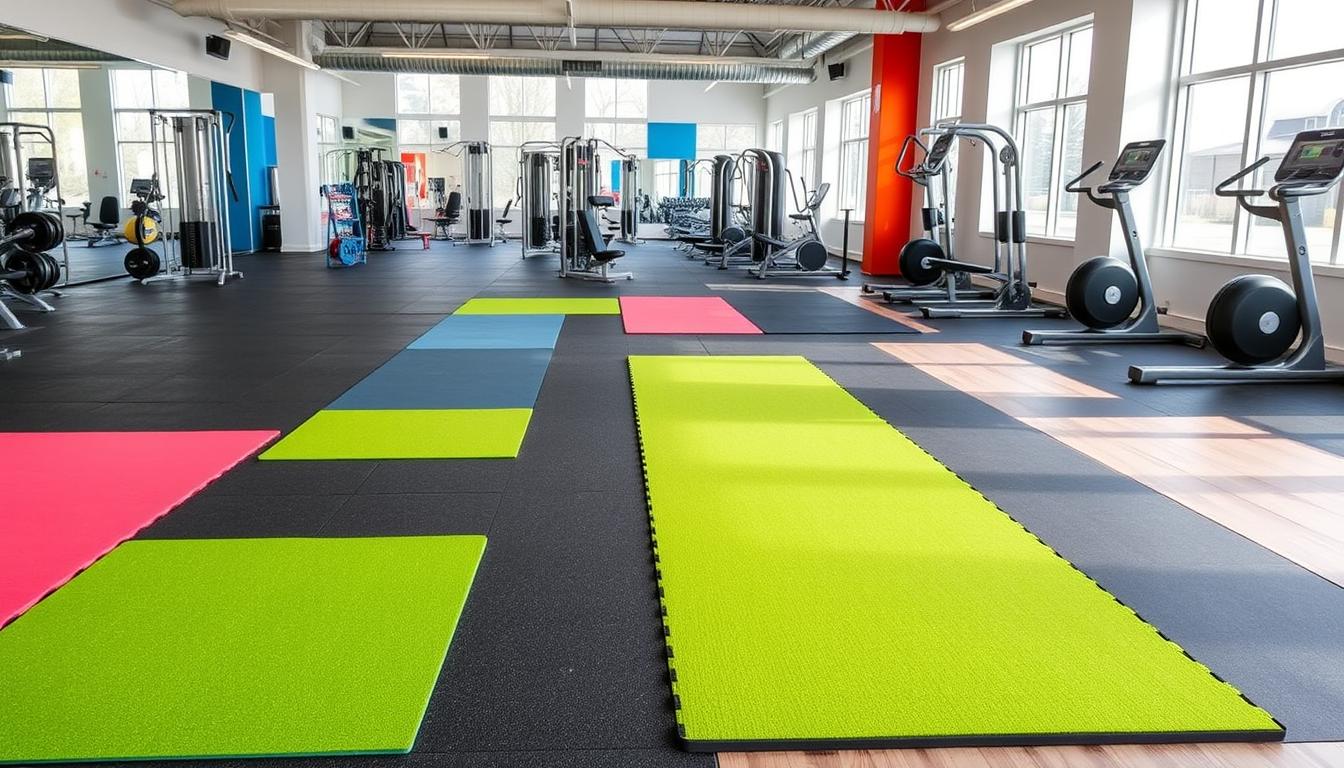I’ve always been drawn to the world of sports and the hard work of athletes. I often think about the athletic trainers who work behind the scenes. They do so much more than just tape ankles and give out ice packs.
Being an athletic trainer is a calling that needs medical knowledge, physical therapy skills, and a deep commitment to athletes’ health.
If you love sports medicine and want to help athletes, being an athletic trainer might be for you. In this guide, we’ll look at the main duties, education needed, and career chances for those who choose this path.
Table of Contents
Overview of Athletic Trainer Role
athletic trainer job description: key qualifications, daily tasks, and career growth opportunities in sports medicine and rehabilitation.”Athletic trainers are key players in sports medicine. They focus on preventing, diagnosing, and treating injuries in athletes. They work with doctors, physical therapists, and others to give athletes the best care.
Definition of an Athletic Trainer
An athletic trainer is a healthcare expert in injury and illness prevention and treatment. They use their knowledge of sports medicine, athlete assessment, and therapeutic exercises to help athletes perform well and recover from injuries.
Importance in Sports and Health
Athletic trainers are vital in sports, acting as the first defense against injuries. They keep athletes safe, healthy, and performing well. They prevent injuries, provide immediate care, and guide recovery, all crucial for athlete wellness.
Career Growth Opportunities
The need for athletic trainers is growing, with the field expected to expand. As awareness of sports injuries and athlete healthcare grows, so does the demand for skilled trainers. They can work in schools, professional sports, healthcare, and more.
| Statistic | Value |
|---|---|
| Estimated time required to become a certified athletic trainer | 4 to 6 years |
| Athletic trainer’s annual salary range in the United States | $50,000 – $80,000 |
| States requiring certification from the Board of Certification for the Athletic Trainer (BOC) | Many |

“Athletic trainers significantly impact injury prevention, patient education, and health care costs by facilitating efficient care, improving patient outcomes, decreasing absenteeism, and ensuring compliance with health care regulations.”
Core Responsibilities of an Athletic Trainer
Athletic trainers are key members of the sports medicine team. They focus on keeping athletes healthy. Their main tasks include injury prevention, emergency care, and rehabilitation. They work with doctors to help athletes get better.
Injury Prevention Strategies
Athletic trainers are always ready to prevent injuries. They create injury prevention programs for each athlete. This includes strength and conditioning, stretching, and teaching safe techniques.
Providing Immediate Care
When injuries happen, athletic trainers act fast. They give emergency care and help stabilize the athlete. They decide if the athlete needs treatment, a doctor’s visit, or to go to the hospital.
Rehabilitation and Recovery Support
After an injury, athletic trainers help with rehabilitation. They make plans to help the athlete get better. They guide the athlete through exercises and treatments to regain strength and function.
Collaboration with Medical Professionals
Athletic trainers connect athletes with the medical team. They work with doctors and physical therapists. This ensures athletes get the best care for injury prevention, emergency care, and rehabilitation.

“Athletic trainers are the unsung heroes of the sports world, working tirelessly behind the scenes to keep athletes healthy and performing at their best.” – Dr. Sarah Johnson, Sports Medicine Specialist
Required Education and Training
To become an athletic trainer, you need a lot of education and training. You must get at least a bachelor’s degree in athletic training or a similar field. Most states also require you to be licensed or certified to work legally.
Educational Background
The path to becoming an athletic trainer starts with a four-year undergraduate program. This program must be accredited by the Commission on Accreditation of Athletic Training Education (CAATE). It covers topics like anatomy, physiology, and how to treat injuries.
Certification and Licensing Requirements
After finishing your education, you need to get certified by the Board of Certification (BOC) for the Athletic Trainer (AT). You must pass the BOC exam and have a degree from a CAATE-accredited program. Most states also need you to have a state license or registration to work.
Continuing Education Opportunities
To keep your certification, you must take ongoing continuing education. You need to complete a certain number of continuing education units (CEUs) every few years. Some jobs, especially leadership roles, might require a master’s degree in athletic training or a related field.

| Educational Requirement | Certification | Licensing |
|---|---|---|
| Bachelor’s degree in athletic training or related field | Board of Certification (BOC) for the Athletic Trainer (AT) | State-specific licensure or registration |
| Master’s degree preferred for leadership roles | Ongoing continuing education units (CEUs) | Varies by state |
Key Skills and Qualifications
To be a great athletic trainer, you need both technical skills and people skills. Good trainers are caring, make smart decisions, pay attention to details, and communicate well. These skills help them support athletes, work with doctors, and give excellent care.
Essential Skills for Success
- Empathy and patient-centered approach
- Critical thinking and problem-solving skills
- Meticulous attention to detail
- Physical dexterity and endurance
- Ability to work well under pressure
Importance of Communication Skills
As an athletic trainer, you’ll talk to many people. This includes athletes, coaches, parents, and doctors. You must speak clearly and simply. This helps you understand what players need, explain treatment plans, and work with the medical team.
Empathy and Patient Care
Empathy is key for athletic trainers. They often help athletes who are hurt and feeling down. Showing kindness and understanding helps build trust. It also supports the well-being of those you care for.
| Key Skills | Importance |
|---|---|
| Interpersonal Skills | Effective communication and collaboration with athletes, coaches, and medical professionals |
| Decision-making Abilities | Quickly assess and respond to various situations, often under high-stress conditions |
| Attention to Detail | Crucial for accurately documenting injuries, treatments, and rehabilitation progress |
| Physical Demands | Ability to lift, bend, walk, and demonstrate manual dexterity to provide hands-on care |
With the right skills, knowledge, and empathy, athletic trainers can greatly impact athletes’ lives. They help athletes reach their goals while keeping their health and safety first.
Work Environments for Athletic Trainers
Athletic trainers work in many places, from professional sports to corporate wellness. They are key in sports medicine and injury prevention. This makes them valuable in many settings.
High School and College Sports
Many athletic trainers work in high school and college sports. They help student-athletes with injuries, create rehab plans, and prevent injuries. They often work odd hours, like during practices and games.
Professional Sports Teams
Working for a professional sports team is exciting and fast-paced. Athletic trainers here focus on elite athletes’ health. They work with doctors and physical therapists to improve performance and manage injuries. Travel and irregular hours are common.
Clinical and Corporate Settings
Athletic trainers also work in clinics and corporate wellness. In clinics, they help with rehabilitation and prevention for all ages. In corporate settings, they focus on employee health through injury prevention and education.
| Work Environment | Typical Job Duties | Work Schedule |
|---|---|---|
| High School/College Sports | Immediate injury care, rehabilitation, preventative strategies | Irregular hours, including evenings and weekends |
| Professional Sports Teams | Injury management, performance optimization, travel with team | Frequent travel, irregular schedules |
| Clinical/Corporate Settings | Rehabilitation services, preventative care, employee wellness | More regular business hours |

Athletic trainers are crucial in many areas, from sports to corporate wellness. Their skills in injury prevention and rehabilitation are invaluable. They help keep people healthy and active in various settings.
Difference Between Athletic Trainers and Personal Trainers
Athletic trainers and personal trainers both aim to improve physical health. But they have different roles and responsibilities. Athletic trainers are healthcare pros who prevent, diagnose, and treat sports injuries. They work under a doctor’s supervision, often in schools, colleges, and sports teams.
Personal trainers help improve health and fitness through exercise and nutrition plans. They work with the general public, athletes, and those with health needs.
Scope of Practice
Athletic trainers handle injury assessment, emergency care, and rehabilitation. They also decide when athletes can return to play. Personal trainers create fitness programs for clients to reach their health goals.
Target Populations
Athletic trainers mainly work with athletes, from young to professional levels. They help prevent, manage, and recover from injuries. Personal trainers work with a broader range of clients, including the general public and athletes.
Training and Education
To be an athletic trainer, you need a bachelor’s degree in athletic training and BOC certification. Personal trainers have various education and certification levels. This can range from a high school diploma and a personal training certification to a degree in exercise science.
“Effective communication between the athlete, the personal trainer, and the coach is crucial for aligning goals and maximizing performance.”
Both athletic trainers and personal trainers are key in promoting physical health. Their unique areas of expertise, target populations, and education make them valuable in different settings.

Salary Expectations and Job Outlook
Thinking about becoming an athletic trainer? It’s important to know the salary range and job outlook. In the United States, athletic trainers earn a median of $57,930 per year. But, salaries can change a lot based on experience, education, location, and where you work.
The lowest-paid 10% make under $43,180 yearly, while the top 10% earn more than $80,640. Those working in schools earn a median of $59,890. In hospitals, the median is $57,390.
| Industry | Median Annual Salary |
|---|---|
| Fitness and Recreational Sports Centers | $53,820 |
| Offices of Physical, Occupational, and Speech Therapists, and Audiologists | $53,120 |
The job outlook for athletic trainers is bright. The U.S. Bureau of Labor Statistics predicts a 14% growth rate from 2022 to 2032. This is much faster than the average for all jobs. The growth is due to more people getting sports injuries and an older, more active population needing trainers.
Whether you want to work in schools, hospitals, or professional sports, athletic training offers a promising career. It comes with good pay and chances for advancement.

Daily Activities of an Athletic Trainer
As an athletic trainer, your day is packed with tasks to help athletes stay healthy and perform well. You’ll check for injuries, create treatment plans, and give emergency care. You also keep detailed medical records.
Routine Tasks
Your day might start with injury screenings and teaching athletes about safety. You work with doctors to make rehab plans. You watch athletes, give first aid, and check if they’re using safety gear right.
Game-Day Responsibilities
Game days are different. You focus on quick care for athletes. You watch players closely and act fast if someone gets hurt. Your skills in injury prevention and rehabilitation are key.
Administrative Duties
You also do office work. This includes writing down treatments, managing money, and setting up meetings. You work with coaches, doctors, and others. Keeping records right and following rules is important.
Your job is varied, aiming to keep athletes safe and healthy. Your work in injury prevention, quick care, and rehabilitation is crucial. You’re a vital part of the sports medicine team.

Tools and Equipment Used by Athletic Trainers
Athletic trainers are key members of the sports medicine team. They use many tools and equipment to care for athletes. These include essential medical devices and the latest technology.
They use these resources to prevent, assess, and treat injuries. They also help with rehabilitation and recovery.
Essential Medical Equipment
Athletic trainers have toolkits with taping and bracing materials. This includes elastic kinesiology tape, athletic tape, and splints. These items support injured joints, muscles, and ligaments.
They also use rehabilitation equipment like exercise balls and resistance bands. Foam rollers help athletes regain strength and flexibility. Modalities like ultrasound machines and electrical stimulation devices aid in healing.
Technology and Software
Technology is vital for athletic trainers. They use software for record-keeping, injury tracking, and treatment planning. This digital help improves their workflow and patient care.
Diagnostic tools like goniometers and pulse oximeters help them assess injuries. They also monitor athletes’ vital signs during evaluations.
Safety Gear
Athletic trainers focus on safety in high-risk sports. They wear protective gear like face masks and gloves. They also ensure athletes have the right protective equipment.
This includes helmets, mouthguards, and padding. It helps reduce injury risk during practices and competitions.
Athletic trainers need to keep up with sports medicine advancements. By using a wide range of tools, they can better meet their athletes’ needs. This supports their health and performance.
Challenges Faced by Athletic Trainers
Athletic trainers are key members of sports medicine teams. They deal with high-pressure situations, demanding schedules, and athlete expectations. They need to be resilient, adaptable, and make ethical decisions.
Common Stressors
Trainers work in fast-paced, high-intensity environments. They make critical decisions under pressure. Long hours and emotional stress from injured athletes can harm their well-being.
Burnout is a big issue in this field. Over 40 studies have looked into it.
Dealing with Athlete Expectations
Trainers balance athletes’ desire to play with their health needs. They face stress from coaches, parents, and athletes. They must make decisions that put the athlete’s health first, even if it’s hard.
Balancing Health and Performance
Trainers aim to promote health and support performance. They often face financial constraints. They must find creative ways to provide care and access to resources.
They make quick, high-stakes decisions that affect athletes’ health and future.
“The role of school athletic trainers involves making quick decisions regarding student-athletes’ health during games and practices, often under high pressure and scrutiny from coaches, parents, and athletes themselves.”
As sports medicine care demand grows, addressing athletic trainers’ challenges is key. It ensures athletes’ well-being and the success of the profession.
Benefits of Being an Athletic Trainer
Being an athletic trainer comes with many rewards. You get to help athletes recover from injuries and reach their goals. You can work in different settings, from high school to professional teams.
Job Satisfaction Factors
Athletic trainers find joy in their work. They make a real difference in athletes’ health and wellbeing. The job also offers chances to learn new things and improve your skills.
Impact on Athlete Lives
You play a key role in helping athletes get back to their sports. You provide care, prevention, and personalized plans. This helps athletes overcome challenges and reach their best.
Opportunities for Advancement
The field of athletic training offers many chances to grow. You can specialize, lead teams, or work in research and education. The need for sports medicine experts means your skills are always in demand.














Leave a Reply